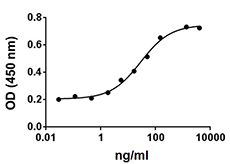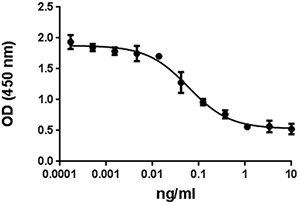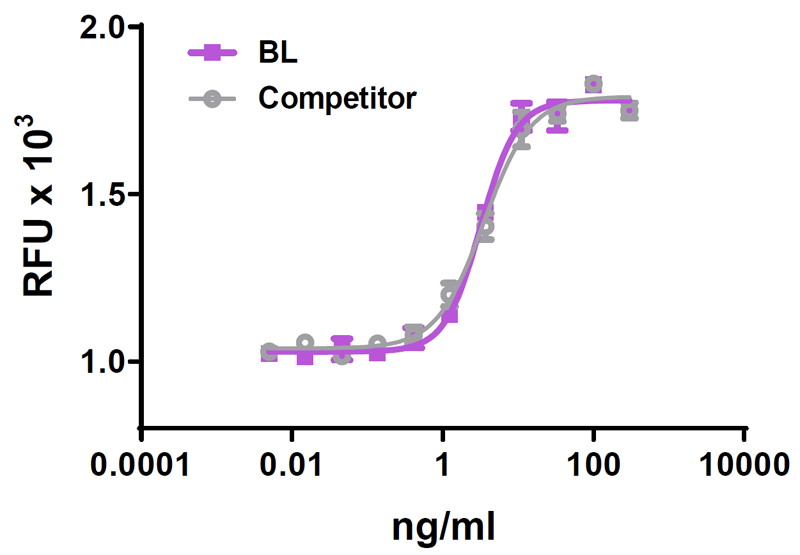- Regulatory Status
- RUO
- Other Names
- Interferon lambda-1, Interleukin-29 (IL-29)
- Ave. Rating
- Submit a Review
- Product Citations
- publications
| Cat # | Size | Price | Save |
|---|---|---|---|
| 711204 | 20 µg | ¥50,350 |
This product is not available for shipping outside of the United States.
IFN-λ1, also known as IL-29, is a member of the type III interferon (IFN) family. Type III interferons, including IFN-λ1, IFN-λ2 and IFN-λ3, are produced upon virus infection and are functionally similar to type I interferon (IFN-α/β). IFN-λ binds to a heterodimeric receptor composed of the IFN-λ receptor 1 (IFNLR1) and the interleukin-10 receptor 2 (IL-10R2), subsequently tranducing signal through the JAK-STAT pathway and leading to transactivation of various IFN-stimulated genes (ISGs). IFN-λ has been demonstrated to mediate an antiviral immune response against several viruses, such as hepatitis B virus (HBV), hepatitis C virus (HCV), and human immunodeficiency virus (HIV). In contrast to type I or type II interferons, IFN-λ receptor is expressed preferentially on epithelial-like cells and some immune cells. Because the response to IFN-λ is highly restricted to certain cell types, IFN-λ is considered a potential therapuetic agent for the treatment of viral diseases with less side effects when compared with type I interferon.
Product DetailsProduct Details
- Source
- Human IFN-λ1, amino acids (Pro23-Thr200) (Accession# NP_742152.1), was expressed in E. coli.
- Molecular Mass
- The 178 amino acid recombinant protein has a predicted molecular mass of approximately 19.8 kD. The predicted N-terminal amino acid is Pro.
- Purity
- >98%, as determined by Coomassie stained SDS-PAGE.
- Formulation
- Lyophilized, carrier-free.
- Endotoxin Level
- Less than 0.1 ng per µg of protein.
- Storage & Handling
- Unopened vial can be stored at -20°C or -70°C. For maximum results, quick spin vial prior to opening. Reconstitute in water to a concentration of 0.1-1.0 mg/ml. Do not vortex. It is recommended to further dilute in a buffer, such as 5% Trehalose, and store working aliquots at -20°C to -80°C. Avoid repeated freeze/thaw cycles.
- Activity
- ED50 = 0.2 - 0.5 ng/ml, corresponding to a specific activity of 2.0 x 106 - 5.0 x 106 units/mg, as measured by its ability to activate STAT phosphorylation in an ISRE Luciferase Reporter Assay using human colon carcinoma COLO205 cells.
- Application
-
Bioassay
- Application Notes
-
This product is reactive with human and monkey.
- Product Citations
-
Antigen Details
- Structure
- Cytokine
- Function
- IFN-λ1 is responsible for mediating an immune response against viral pathogens. Expression of IFN-λ1 is induced by double stranded RNA or virus infection.
- Interaction
- IFN-λ1 targets epithelial cells and hepatocytes, which express the IFN-λ receptor.
- Ligand/Receptor
- IFN-λ1 interacts with the heterodimeric cytokine receptor composed of IL10R2 and IFNLR1.
- Bioactivity
- Human IFN-λ1 is able to induce STAT phosphorylation.
- Biology Area
- Immunology
- Molecular Family
- Growth Factors, Cytokines/Chemokines
- Antigen References
-
1. Swider A, et al. 2014. Cytokine. 65:17.
2. Rauch I, et al. 2013. JAKSTAT 2:e23820.
3. Lasfar A, et al. 2011. Clin. Dev. Immunol. 2011:349575.
4. Donnelly RP, et al. 2011. Trends Immunol. 32:443.
5. Kelly C, et al. 2011. Gut. 60:1284.
6. Donnelly RP and Kotenko SV. 2010. J. Interferon. Cytokine Res. 30:555. - Gene ID
- 282618 View all products for this Gene ID
- UniProt
- View information about IL-29 on UniProt.org
Related Pages & Pathways
Pages
Related FAQs
- Why choose BioLegend recombinant proteins?
-
• Each lot of product is quality-tested for bioactivity as indicated on the data sheet.
• Greater than 95% Purity or higher, tested on every lot of product.
• 100% Satisfaction Guarantee for quality performance, stability, and consistency.
• Ready-to-use liquid format saves time and reduces challenges associated with reconstitution.
• Bulk and customization available. Contact us.
• Learn more about our Recombinant Proteins. - How does the activity of your recombinant proteins compare to competitors?
-
We quality control each and every lot of recombinant protein. Not only do we check its bioactivity, but we also compare it against other commercially available recombinant proteins. We make sure each recombinant protein’s activity is at least as good as or better than the competition’s. In order to provide you with the best possible product, we ensure that our testing process is rigorous and thorough. If you’re curious and eager to make the switch to BioLegend recombinants, contact your sales representative today!
- What is the specific activity or ED50 of my recombinant protein?
-
The specific activity range of the protein is indicated on the product datasheets. Because the exact activity values on a per unit basis can largely fluctuate depending on a number of factors, including the nature of the assay, cell density, age of cells/passage number, culture media used, and end user technique, the specific activity is best defined as a range and we guarantee the specific activity of all our lots will be within the range indicated on the datasheet. Please note this only applies to recombinants labeled for use in bioassays. ELISA standard recombinant proteins are not recommended for bioassay usage as they are not tested for these applications.
- Have your recombinants been tested for stability?
-
Our testing shows that the recombinant proteins are able to withstand room temperature for a week without losing activity. In addition the recombinant proteins were also found to withstand four cycles of freeze and thaw without losing activity.
- Does specific activity of a recombinant protein vary between lots?
-
Specific activity will vary for each lot and for the type of experiment that is done to validate it, but all passed lots will have activity within the established ED50 range for the product and we guarantee that our products will have lot-to-lot consistency. Please conduct an experiment-specific validation to find the optimal ED50 for your system.
- How do you convert activity as an ED50 in ng/ml to a specific activity in Units/mg?
-
Use formula Specific activity (Units/mg) = 10^6/ ED50 (ng/mL)













Follow Us